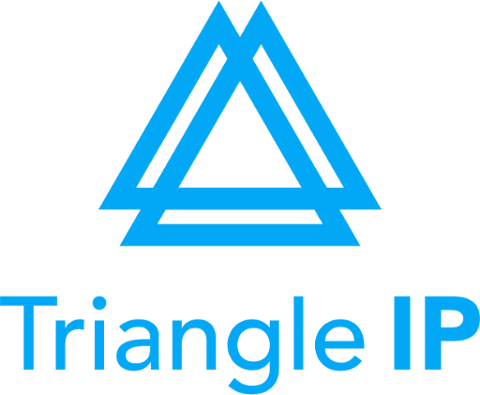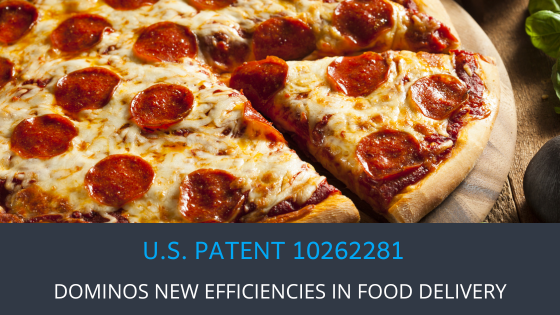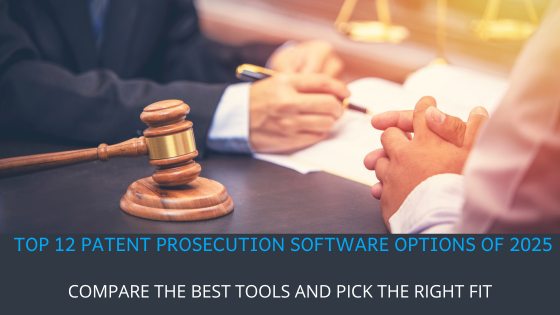In the bustling world of food delivery, timely and accurate updates are essential. Domino’s LLC addresses this need head-on with U.S. Patent 10262281, revolutionizing how customers track their orders.
This patent introduces a decentralized system, where a single identifier, such as a phone number, connects customers directly to real-time updates about their orders via web, phone, or messaging. This eliminates the need for multiple contact points or specific location knowledge, simplifying the tracking process.
Domino’s innovative approach not only enhances customer experience by providing a seamless tracking system but also streamlines operational logistics. It frees staff from constantly responding to order inquiries, thereby improving service efficiency.
For innovators and industry leaders, U.S. Patent 10262281 is a beacon, illuminating how technology can simplify complex systems, improve customer interaction, and optimize business processes in the fast-paced world of food service. This article discovers more about how this patent solves problems and inspires a new wave of innovation.
So, let’s dive in!
A Brief Overview Of U.S. Patent 10262281
U.S. Patent 10262281, issued on April 16, 2019, describes a method and system for centralized order status tracking in a decentralized ordering system. This patent was filed on June 11, 2007, and the assignee is Domino’s IP Holder LLC.
This patent focuses on a system where customers can track the status of their orders from a central system rather than having to contact individual locations. The key features of this system include:
Centralized Tracking with No Login: Utilizing a single unique identifier, such as a telephone number, customers can easily track their orders without the need to log in. This approach is facilitated through a dedicated website or a toll-free phone line, streamlining the process and enhancing user-friendliness. Customers no longer need to remember login credentials to handle or place their orders, making the system more accessible and convenient.
Automated Status Notifications: The system enhances customer convenience by automatically sending notifications about the order’s progress. Customers receive timely updates through email, text, or voice messages and are informed about stages like preparation, baking, and delivery.
Decentralized Order Processing: While the order processing is decentralized across various locations, the tracking remains centralized for customer ease. The system intelligently assigns orders to the optimal location based on factors such as delivery proximity.
System Configuration and Integration: The patent details the technical configuration of the system, including the central computer system at the central location, the order processing computer systems at the decentralized locations, and how these components interact to provide real-time order status updates.
Source: Dominos242
Historical Context Of The U.S. Patent 10262281
The origin of U.S. Patent 10262281, assigned to Domino’s IP Holder LLC, can be traced back to the limitations of previous food delivery systems. Traditional methods typically require customers to contact individual restaurant locations directly to get updates on their orders. This approach had several drawbacks:
Increased Workload for Restaurant Staff: The staff at each restaurant location had to manage numerous order status inquiries, which was time-consuming and diverted their attention from other operational tasks.
Lack of Real-Time Tracking: Earlier methods did not provide real-time order tracking. Customers could not easily find out the current status of their order (e.g., whether it was being prepared, baked, or out for delivery), leading to uncertainty and a less satisfying customer experience.
Limited Communication Channels: The primary method of communication was through telephone calls. There were limited or no alternatives like text messages, emails, or online tracking, which restricted the convenience for customers, especially those who preferred digital communication methods.
No Automated Notifications: Older systems did not have the capability to inform customers about the status of their orders. Customers had to proactively seek out this information, which could be time-consuming and frustrating automatically.
U.S. Patent 10262281 introduced a novel, customer-focused approach to address these issues.
Source: Twitter
This system allows customers to use a single, easily remembered identifier, such as their telephone number, to check the status of their orders. It offers both web-based and telephonic interfaces for order status inquiries. This eliminated the need for customers to contact individual restaurant locations.
By relieving restaurant staff from handling order status inquiries and providing customers with an easy-to-use tracking system, the patented system significantly improved operational efficiency and enhanced the overall customer experience.
Must Read: U.S. Patent 4686605- Is It A Game Changer for Geoengineering?
The Inventors Behind U.S. Patent 10262281
The inventors listed for this patent are James G. Vitek, David W. Haubenstricker, Eric R. Sweetland, and Timothy J. Wise.
David W. Haubenstricker and James G. Vitek, two of the inventors, have been involved in filing for several patents, protecting a range of inventions. Their patents span various topics, including methods and systems for centralized order status tracking, routing food orders over a computer network, and methods for determining dispatch assignments of delivery orders.
These inventions reflect their expertise in systems design, particularly in order processing and management in decentralized networks.
Common Challenges And Setbacks During Development Of U.S. Patent 10262281
Here are some common challenges that are typically encountered in the development of such complex technological systems:
Integration with Existing Systems: One of the major challenges in developing a centralized order tracking system for a decentralized network, such as different restaurant locations, is ensuring seamless integration with the existing diverse systems. Each location might have its own order processing systems, and integrating these with a central tracking application requires significant technical expertise.
Real-Time Data Accuracy: Ensuring real-time data accuracy in a system where multiple inputs are constantly updated (like order status from various locations) is a complex challenge. The system must handle and process these updates efficiently and accurately to provide real-time status to customers.
Scalability and Reliability: As the system is intended for use across multiple locations, ensuring that it can scale effectively to handle large volumes of orders without compromising performance is crucial. Similarly, reliability is key; any downtime or errors could directly impact customer satisfaction and business operations.
User Experience Design: Developing an interface that is easy and intuitive for both customers and staff of the decentralized locations is another challenge. The system must be accessible and user-friendly to ensure widespread adoption and effective usage.
Data Privacy and Security: Handling customer data, especially identifiers like phone numbers or email addresses, requires adherence to data privacy laws and standards. Ensuring the security and privacy of this data during transmission and storage would be a significant focus during development.
Testing and Quality Assurance: Rigorous testing is needed to ensure the system works as intended in various scenarios, including peak business hours, different geographic locations, and under different network conditions.
Addressing developmental challenges is crucial in keeping a patent viable, showcasing the intricate mix of technical, operational, and user-focused elements in innovation.
The true testament to this technology’s success, however, is reflected in its acceptance by end-users. Let’s now explore the public’s response to this patent, understanding how it meets or diverges from user expectations.
Public Perception And Views On The U.S. Patent 10262281
The public perception of Domino’s Pizza Tracker, as featured in U.S. Patent 10262281, seems to be mixed. Various sources have highlighted concerns about the tracker’s accuracy, particularly in relation to the real-time status of pizza preparation and delivery.
One investigation, as reported on PopCulture, involved a writer conducting a personal test by ordering a pizza and observing the discrepancies between the tracker’s updates and the actual status of the pizza. The findings indicated that the tracker’s progress updates did not always align with the real-time activities in the restaurant, suggesting that the tracker might operate on pre-timed estimates rather than actual, live updates.
Source: Twitter
Mashed also reported on the accuracy of the Pizza Tracker, noting that while Domino’s claims the tracker is based on real store operations, it requires human interaction, which can sometimes lead to errors. The article pointed out that, in some cases, the delivery times and personnel reported by the tracker didn’t match reality, leading to skepticism about its accuracy. It was also mentioned that certain locations and drivers might feel pressured to manipulate the system to avoid negative impacts on their performance ratings within the company.
The Daily Meal further highlighted that the tracker’s accuracy depends on the employees at each location. It was noted that employees can sometimes “cheat” the system, leading to inaccuracies in the tracker’s updates. The tracker’s functionality was described more as an update tool on the completion of certain stages of the pizza-making process rather than a real-time tracking of the pizza itself.
Culminating the discussion on public opinion, it’s evident that these perspectives set the stage for evolving the technology behind U.S. Patent 10262281. So, let’s take a closer look into its future implications, as it promises to transform the customer experience and business operations across diverse sectors.
Future Implications Of U.S. Patent 10262281
The system outlined in this patent provides several advantages:
Improved Customer Experience: The patent introduces a groundbreaking method for order tracking, revolutionizing customer service across various sectors. This enhanced, user-friendly system is expected to greatly increase customer satisfaction and loyalty, potentially elevating the reputation of businesses that implement it by offering a smoother customer journey.
Synergy with Advanced Technologies: This patent facilitates integration with innovative technologies like AI, ML, and IoT. It enables developing sophisticated tracking and notification systems, offering personalized customer services and predictive analytics. The result is a more intelligent, anticipatory service model that adapts to customer needs and preferences.
Transformation of Business Processes: U.S. Patent 10262281 heralds a significant shift towards automated and decentralized business operations. It streamlines order management, reduces costs, and enhances scalability, setting a new standard for efficiency and adaptability in various industries.
Diverse Industry Applications: Originally aimed at food services, this patent’s methodology holds promise for a broad spectrum of industries, including retail, logistics, healthcare, and other service sectors. Its implementation could dramatically boost operational efficiency and customer engagement in these areas.
This patent could potentially influence how businesses approach order tracking and customer interaction, especially in industries where timely and efficient service is crucial.
For innovators exploring how past inventions shape future solutions, patent search platforms like Global Patent Search offer powerful tools to uncover prior art, track technological evolution, and accelerate idea validation.
Its intuitive, AI-powered interface bridges the gap between inspiration and execution making it a valuable resource for research-driven industries.
Leverage The TriangleIP TIP Tool™ To Streamline Your Patent Program
U.S. Patent 10262281 from Domino’s LLC demonstrates the power of innovation in solving real-world problems.
This patent represents more than just a technological advance; it signifies a leap forward in improving customer experience and operational efficiency in the dynamic world of food service.
Innovation is complex, and patenting is even more so, requiring data-driven decisions. Innovation managers seeking to harness enterprise-wide creativity and build a strategic patent portfolio turn to TriangleIP’s TIP Tool™ for streamlined patent program management. Here’s why
Idea to Patent Tracking: Simplify your innovation management process with the TIP Tool™. Its drag-and-drop interface allows seamless progression through stages like ‘Idea Capture,’ ‘Internal Vetting,’ ‘Patent Drafting,’ and ‘Filed Patents.’
Inventor-Friendly Idea Capture: Overcome the reluctance of inventors to fill out complex forms. The TIP Tool™ features an easy-to-use Invention Disclosure Form (IDF), encouraging more submissions of patentable ideas.
Real-Time Collaboration: Foster efficient idea vetting with a Google Docs-like interface. The TIP Tool™ enables collaborative editing, review, and tracking of ideas, ensuring comprehensive evaluation from multiple perspectives.
Controlled Access Dashboards: Protect sensitive IP information in your enterprise. The TIP Tool™ offers role-based access controls, ensuring employees only see what they need.
Case Analytics: To optimize patent prosecution strategy, it’s crucial to consider key factors: allowance likelihood, argument rounds, timeline, costs, patent counsel and examiner analytics, etc. The TIP ToolTM delivers these insights through deep analysis of extensive patent documents. For instance, here are the predictions by the TIP Tool for the U.S. Patent 10262281.
| Check Points | The TIP Tool™ Predictions | Actual Information |
| Average Allowance Time | 3 years | Applied in 2007, Granted in 2019 ~11 years |
| Average Argument Rounds | 1.7 | Not Available |
| Average Allowance Rate | 78% | 100% (As it’s an issued patent) |
| End-To-End Patenting Cost Estimation | $40,280 The maintenance fee for the 2nd cycle is due on 04-16-2027 | Not Available |
| Art Unit | 3627, 2652, 2651 | Group Art Unit (GAU) – 3623 |
| Examiner Analytics | Sterrett, Jonathan GAvg. Allowance Rate – 69% Avg. Argument Rounds – 1.6Avg. Allowance Time – 1.9 years | Sterrett, Jonathan G |
Informative Dashboards: Gain valuable insights into the patent pipeline with ease. The TIP Tool™ provides diverse dashboards, helping innovation managers assess patent negotiation prospects and costs and track team members’ key performance indicators (KPIs).
USPTO Status Updates: Stay informed with automatic updates from the U.S. Patent Office. The TIP Tool™ updates you on critical developments like office actions and maintenance fee deadlines.
Register on the TIP ToolTM today to streamline your patent program!
If you are evaluating the options to make a strategic decision, explore our guide on Choosing the Best Patent Management Software for Medium-Sized Enterprises.





